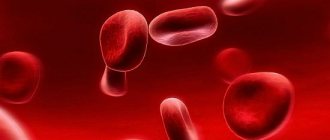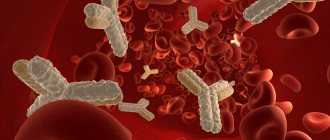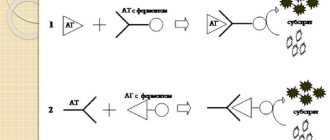Irritation and rashes on the skin, difficulty breathing, itching - all these are clear signs of an allergy. Allergy – literally translated from Latin as “another reaction” – is the body’s response to incoming irritants. The substance can enter the body through the skin, respiratory tract or through food.
An “irritant” that causes an allergy is not necessarily a harmful substance, it’s just that the body of a particular person cannot cope with it. Despite the fact that allergens are individual for each person, many years of experience have allowed doctors to compile a list of products to which in many cases a negative reaction occurs ( immunoglobulin E ).
It includes: citrus fruits, exotic fruits and vegetables, eggs, sea fish, milk, honey and spices, chocolate, dust, perfume and all cosmetics, chemical aerosols, pollen of trees and flowers. Allergic reactions can also occur to certain fabrics, animals (especially those with a lot of fur), upholstery and paint.
What is IgE?
Immunoglobulin E is a protein, a specific type of antibody. It is produced in a healthy body in small quantities, but this is enough to attack viruses and bacteria.
This protein was discovered in the sixties. It was discovered during an examination of patients who suffered from blood cancer and atopy. The concentration of immunoglobulin E in the blood is 0.2% of the amount of other components.
The main target of the protein in question is various allergens. If a person has a high sensitivity to a specific pathogen, his body activates the immediate production of IgE.
When an allergy develops, the human body triggers the production of immunoglobulin E in colossal concentrations, as a result of which it seeps into the skin, respiratory tract, tonsils, and gastrointestinal tract.
When an allergen attaches, special elements called mediators are formed. It is these substances that provoke the occurrence of all allergy symptoms - nasal congestion, itching of the larynx, tearing and rash on the skin.
Immunoglobulin takes an active part in the formation of anthelmintic immunity. Protein synthesis occurs during the prenatal period.
If a pregnant woman suffers from severe allergic reactions, then specialists will order a cord blood test. If the result shows increased levels of the mentioned protein, the medical specialist concludes that the child has a high risk of progression of atopic diseases.
IgE reference values
Unlike globulins A, M, G, type E antibodies are contained in very modest quantities in the blood. Plasma protein concentration increases sharply when allergenic agents invade the body, as an indicator of an immediate reaction. An increased level of antibodies indicates a tendency to allergies.
High indicators, such as an immune response, confirm the presence of an antigen in the body. Immunoglobulin E levels are not classified by gender. The number of antibodies increases from birth to puberty. In older people, the concentration of IgE and other antibodies decreases.
This is due to age-related characteristics of the weakening of the body's defenses. Therefore, different reference values are adopted for adults and children. The measurement value for a protein compound is taken to be IU/ml (international units) or kE/L (kilounits per liter).
Standard indicators of blood tests for immunoglobulin E in children and adults
| Age | up to a year | 1–2 years | 2–3 years | 3–9 years | 9–15 years | adults |
| Reference values in IU/ml | 0–29 | 0–49 | 0–45 | 0–53 | 0–200 | 0–100 |
An increase in antibody concentration is recorded during plant flowering (spring and summer). In adults, levels can reach 250 IU/ml. The lowest level is observed in winter. Deviation of reference values towards increase or decrease means the presence of pathological processes in the body.
Why take Immunoglobulin E?
Even the slightest deviation from the established norm indicates that various atopic reactions are occurring in the body. But it is not enough for specialists to identify the presence of an allergy; often, for the patient’s health, it is necessary to identify a specific allergen that interferes with normal existence.
There are several symptoms that are a clear indicator that it is necessary to get tested for IgE antibodies:
- various rashes;
- severe itching;
- nettle fever;
- shortness of breath or bronchial asthma;
- Quincke's edema;
- bronchitis;
- irritant dermatitis;
- the presence of a seasonal allergic reaction;
- damage to the body by parasites.
When the immunoglobulin E level exceeds the established barrier, this is evidence of confirmation of the previously established diagnosis.
Preparing for the study
Determining the exact amount of the protein in question in the blood is a rather labor-intensive process.
To conduct a blood test for total IgE, you need to thoroughly prepare for it. The patient must completely eliminate alcohol, fatty, salty foods, and spicy foods from his diet in advance. Medical professionals recommend not smoking before starting a blood test for IgE total. Moreover, you should not take any medications a couple of weeks before the date for which the test is scheduled.
If the patient follows the doctor's instructions, the examination result will be more accurate. Consequently, it will be possible to establish a diagnosis faster, which will lead to the prescription of therapy and a speedy recovery.
What does General Immunoglobulin E show: what do the indicators indicate?
When a general blood test is performed, specialists isolate total immunoglobulin E. Total IgE shows the concentration of the protein. Often, the increased content of the element is accompanied by allergic symptoms, which include asthma, dermatitis and urticaria.
Moreover, immunoglobulin E is responsible for the body’s response to all kinds of parasitic lesions.
When a person is struck by an atopic antigen, the production of immunoglobulin begins in huge quantities.
In a normal, healthy state, the content of immunoglobulin E in the blood is low. This means that the body is not susceptible to attack by allergic components, and accordingly, protein is not produced in large volumes.
There is a norm for protein content in human blood. In accordance with its indicators, the specialist diagnoses the presence of allergies, its severity, as well as the active development of more serious ailments.
Types of immunoglobulins
Depending on the structure and function, immunoglobulins are divided into five main classes: G, M, E, A and D.
Immunoglobulin G(IgG)
This type of immunoglobulins constitutes the main class. It is found in blood serum and, in turn, is divided into four subclasses (IgG1, IgG2, IgG3, IgG4), each of which has its own unique functions. The production of immunoglobulin G occurs a few days after the production of immunoglobulin M, after which it remains in the body for a long period of time. Thanks to its anti-infective and anti-parasitic properties, immunoglobulin G ensures the elimination of infections, all kinds of viruses and fungi.
Immunoglobulin M (IgM)
The production of immunoglobulin M in the human body begins immediately after foreign agents enter it. These antibodies are called “alarming”. At the beginning of the development of any disease, there is a rapid increase in their number. The main task of immunoglobulins M is to provide the body’s initial defense when infections occur.
Immunoglobulin E (IgE)
Immunoglobulins E are specific antibodies, the appearance of which can be caused by an atopic type of allergy or worms. As a rule, normal immunoglobulin E is almost not observed in the blood.
Immunoglobulin A (IgA)
These antibodies help form local immunity of the mucous membranes. Immunoglobulins A are activated during the development of acute respiratory diseases and skin infections. Indicators of this type of immunoglobulin are increased in people suffering from alcoholism, chronic liver disease, and also in cases of poisoning.
Immunoglobulin D (IgD)
Immunoglobulin D (IgD) are antibodies with poorly understood functions to date. Most often they are part of medications.
Total Immunoglobulin E: normal in adults
Immunoglobulin E, provided that the body is in a healthy, normalized state, is practically not contained in the blood. It begins to form only when there is an urgent need to protect against infectious influence.
The amount of protein varies depending on the age of the patient.
Before a person reaches adolescence, protein concentrations may increase. The norm for IgE in an adult is from 20 to 100 kU/l.
Immunoglobulin E is normally observed in many patients with allergies. In this case, additional studies are prescribed.
The highest concentration of elements is observed in the spring season. This is due to the fact that it is at this time of year that various plants actively bloom. Based on this, the level of total IgE in adults can range from 30 to 250 kU/l. The lowest level of immunoglobulin E is observed in the winter season.
How to lower immunoglobulin levels?
To reduce the concentration of serum IgE, complex treatment is prescribed, including taking medications - orally and locally and traditional medicine.
Drug therapy
The doctor prescribes treatment taking into account the reason that led to the increase in the number of antibodies, the individual characteristics of the body and the patient’s age.
- Antiallergic drugs that act on H-1 histamine receptors and suppress the action of the antigen - Suprastinex, Zyrtec, Erius, Telfast. Most often, experts recommend taking new generation antihistamines, because the drugs have a minimum of side effects and quickly cope with allergy symptoms;
- Local therapy in the form of non-hormonal creams, gels, ointments that promote skin regeneration - Bepanten, Belosalik, Akriderm. For severe lesions of the epidermis, the use of glucocorticosteroids of various hormonal activities is recommended - depending on the severity of the inflammatory process - Advantan, Lokoid, Prednisolone;
- Drugs to enhance immunity - Arbidol, Amiksin. Currently, the immunity of allergy sufferers is strengthened through the gradual introduction of allergens, which makes it possible to achieve long-term remission;
- If helminthiasis is present, antihelminthic medications are prescribed - Pirantel, Vermox, Mebendazole.
Article on the topic: Allergic conjunctivitis: treatment in adults and children
Blood test for immunoglobulin: norms
Alternative medicine treatment
Traditional healers' remedies will not cure pathology, but they help improve analysis and are part of complex therapy. To lower immunoglobulin levels, the following folk recipes are used:
- decoction of herbal tea - St. John's wort, yarrow, chamomile petals, dandelion root - 1/3 cup before each meal;
- a mixture of eggshells and lemon juice - take 1 teaspoon 3 times a day;
- dandelion and burdock decoction - 1/2 cup before breakfast, lunch, afternoon snack, dinner.
Blood test for immunoglobulin e in children
Increased IgE: causes
If an allergenic antigen penetrates the body, the biological level of immunoglobulin E increases sharply and significantly. This indicator indicates the presence of the following conditions:
- atopic pathologies. These include dermatosis, allergic rhinitis, bronchial asthma, gastroenteropathy;
- diseases of an anaphylactic nature - anaphylaxis and urticaria.
There are specific factors that provoke the appearance of the above ailments. These include:
- dusting of plants;
- dust mites;
- synthetic food additives;
- specific medications;
- components of chemical origin;
- metal derivatives.
Exposure to at least one of the above factors provokes an increase in the biological level of immunoglobulin E.
In addition, the IgE level can increase markedly due to a defect in the T-lymphocyte, which is responsible for the strength and duration of the immune response. In such a situation, an increased level will indicate:
- superimmunoglobulinemia;
- lack of selective IgA protein;
- thymic aplasia;
- uncontrolled growth of IgE protein;
- presence of immunodeficiency from birth.
There is another reason why the amount of protein in the blood increases significantly. It consists of a conflict between host and donor cells after tissue transplantation. In such a situation, the transplanted cells are perceived by the body as a threat. As a result, the host cells begin to fight foreign elements.
It is important to note that a specific diagnosis is made on the basis of a comprehensive examination. No competent doctor diagnoses a disease based solely on the test result.
If the indicator is significantly increased, the patient is prescribed additional allergy diagnostics. Tests are made for different types of allergens. Such an examination helps to identify the cause of the rapid increase in protein.
If the protein level is significantly increased, the patient is urgently prescribed antihistamines, which are approved for long-term, regular use.
Total immunoglobulin E (IgE) in serum
Total immunoglobulins E (IgE) in human serum are gamma globulins produced by B lymphocytes. Their main function is participation in immediate (reagin) type reactions, as well as antiparasitic protection.
Synonyms Russian
Immunoglobulins class E.
English synonyms
Immunoglobulin E, IgE, total (serum).
Research method
Solid-phase chemiluminescent enzyme-linked immunosorbent assay (“sandwich” method).
Determination range: 0.1 - 50000 IU/ml.
Units
IU/ml (international unit per milliliter).
What biomaterial can be used for research?
Venous blood.
How to properly prepare for research?
- Do not eat for 2-3 hours before taking the test; you can drink clean still water.
- Avoid physical and emotional stress for 30 minutes before the test.
- Do not smoke for 3 hours before the test.
General information about the study
Human serum immunoglobulins (Ig, antibodies) are gamma globulins produced by beta lymphocytes. Their main function is the recognition and destruction of antigens. Immunoglobulins consist of 2 heavy (H) and 2 light (L) chains linked by disulfide bridges. Depending on the structure of the H-chains, they are divided into classes: G, M, A, D and E.
Class E immunoglobulins (reagins) are involved in the development of atopic allergic reactions (bronchial asthma, rhinitis, urticaria, atopic dermatitis, etc.). They are able to quickly attach to the surface of mast cells and basophils of the skin and mucous membranes. Therefore, repeated contact of reagin IgE with the antigen (allergen) occurs on the surface of these cells, which leads to the release of vasoactive substances from them (histamine, serotonin, heparin, etc.) and the development of clinical manifestations of type 1 hypersensitivity reaction.
75% of children whose parents suffer from allergic diseases have elevated IgE levels. Among healthy children, elevated levels of total IgE are associated with a 10-fold increase in the risk of developing allergic diseases over the next 18 months compared with children whose blood levels of total IgE are within normal limits. A test for total IgE in blood plasma is used as a screening to identify allergies, but to find the causative allergen, it is necessary to identify specific IgE.
In addition, IgE plays a significant role in the formation of antiparasitic immunity to roundworms, toxoplasma, nematodes, echinococci, trichinella and other parasites, which is due to the ability of IgE to interact with helminth antigens. Therefore, an increase in the level of total IgE in the blood plasma may indicate the presence of parasitic infestation.
What is the research used for?
- For diagnosing allergic diseases and assessing the effectiveness of their treatment.
- For diagnosis, in particular differential, of helminthic infestations.
- To assess the risk of developing allergic reactions in children.
- For the diagnosis of certain immunopathological diseases.
When is the study scheduled?
- If IgE myeloma or other immunopathological diseases are suspected.
- For symptoms of bronchopulmonary aspergillosis.
- For children – when their parents suffer from allergic diseases.
- If a helminthic infestation is suspected.
What do the results mean?
Reference values
| Age | Reference values |
| Newborns | 0 - 1.5 IU/ml |
| Less than 1 year | 0 – 15 IU/ml |
| 1-6 years | 0 – 60 IU/ml |
| 6-10 years | 0 – 90 IU/ml |
| 10-16 years | 0 – 200 IU/ml |
| More than 16 years | 0 - 100 IU/ml |
Reasons for increased levels of total IgE
- Parasitic infestations (ascariasis, intestinal nematodosis, echinococcosis, hookworm disease, amoebiasis, helminth larval migration syndrome).
- Allergic bronchopulmonary aspergillosis.
- Allergic diseases caused by IgE antibodies: atopic (atopic bronchial asthma, allergic rhinitis and sinusitis, atopic dermatitis, drug and food allergies) and anaphylactic (anaphylaxis, urticaria, angioedema).
- Immunopathological diseases (IgE myeloma, periarteritis nodosa, hypereosinophilia syndrome, dysplasia and aplasia of the thymus (DiGeorge syndrome), Wiskott-Aldrich syndrome, hyper-IgE syndrome and recurrent pyoderma (Job-Buckley syndrome), pemphigus (Neumann syndrome), reaction "graft versus host".
Reasons for reducing the level of total IgE
- Hereditary, sex-linked or acquired hypogamma-globulinemia.
- Ataxia-telangiectasia.
- Primary or secondary immunodeficiencies.
Also recommended
- Total immunoglobulin M (IgM) in serum
- Total immunoglobulin G (IgG) in serum
- Total immunoglobulin A (IgA) in serum
- Determination of specific immunoglobulins of class E to animal and bird allergens
- Determination of specific immunoglobulins class E for household allergens
- Determination of specific immunoglobulins class E to mold allergens
- Determination of specific immunoglobulins class E to food allergens
- Determination of specific immunoglobulins class E to helminth allergens
- Determination of specific immunoglobulins class E to drugs
- Determination of specific immunoglobulins of class E to local anesthetics
- Determination of specific immunoglobulins of class E to metals
- Determination of specific immunoglobulins class E to tree pollen allergens
- Determination of specific immunoglobulins class E to grass allergens
- Determination of specific immunoglobulins class E to other allergens
- Determination of specific immunoglobulins class E to insect allergens
- Determination of specific immunoglobulins class E to weed allergens
- Determination of specific immunoglobulins of class E to occupational allergens
- Complete blood count (without leukocyte formula and ESR)
- Leukocyte formula
- Erythrocyte sedimentation rate (ESR)
Who orders the study?
Allergist, pulmonologist, gastroenterologist, therapist, general practitioner, hematologist, pediatrician, rheumatologist.
Literature
- Nazarenko G.I. Clinical assessment of laboratory research results / G.I. Nazarenko, A.A. Kishkun - M.: Medicine, 2006 - 543 p.
- Chernecky CC Laboratory tests and diagnostic procedures / CC Chernecky, BJ Berger; 5th ed. – Saunder Elsevier, 2008. – 1232 pp.
- Kishkun A.A. Immunological and serological studies in clinical practice / A.A. Kishkun. – Medical Information Agency LLC, 2006. – 536 p.
Low Immunoglobulin E levels in adults: causes
In practice, it has been observed that there are patients who do not produce this protein at all. This phenomenon is extremely rare, but exists. If the result shows that immunoglobulin E is low in an adult, then this is clear evidence of the presence of such ailments as:
- immunodeficiency. Moreover, it can be congenital or acquired over time;
- late stage cancer;
- ataxia resulting from a T-cell defect, telangiectasia;
- Non-IgE myeloma;
- anemia, in which there are disturbances in blood flow.
An immunoglobulin E test can show a lot and prevent the further progression of any illness.
Whatever the nature of the root cause of the low or high content of the protein in question, much attention in treatment is paid to increasing the body’s immunity.
Medical experts recommend maintaining a healthy lifestyle. Of course, each case is unique and requires an individual approach, so self-medication is not recommended.
How to get tested?
When taking an analysis for the content of protein cells, you should adhere to the same rules that are typical for any biochemical blood test.
How to take an immunoglobulin E test
Preparation for analysis involves:
- Blood is donated strictly on an empty stomach in the morning, that is, at least 8 hours must pass after eating. It is permissible to drink non-carbonated water before taking the test;
- 2 days before the analysis, it is advisable to exclude salted, smoked, fried foods, and alcoholic beverages;
- It is advisable not to abuse tobacco smoking 24 hours before the test;
- 2-3 days before blood sampling, avoid stressful situations, severe physical and mental stress;
- when taking medications, warn your doctor or laboratory technician to avoid distortion of the analysis;
- On the day of the test, it is not advisable to conduct an ultrasound examination, fluorography, or physiotherapeutic measures - take the test on another day.
Important! If you have doubts about an increased or decreased concentration of immunoglobulin E, it is permissible to retake the blood test in another laboratory.
Analysis for Immunoglobulin E: explanation
There is a clear distinction between the indicators of the protein in question, each of which is evidence of the presence of a specific disease.
- In asthma, the amount of IgE will vary from one hundred twenty to one thousand two hundred IU/ml.
- For allergic rhinitis - from one hundred twenty to one thousand IU/ml.
- For hyperimmunoglobulinemia - from one thousand to fourteen thousand IU/ml. For myeloma - more than fifteen thousand IU/ml.
- For atopic dermatitis - from eighty to fourteen thousand IU/ml.
Gender does not influence the examination result. However, experts advise women who have reached childbearing age to consult with a medical professional before the test to determine the best date for the test. This is due to the influence of the menstrual cycle on protein content.
The immunoglobulin E level may be increased, which will indicate a mild course of the disease. Or it may seriously exceed the norm, this will be an indicator of an acute form of the disease. To record the allergen and the root cause of the disease, you need to trust only a medical specialist to interpret the results.
Features of the analysis
It is important to properly prepare for the test. To do this, you should eliminate physical and emotional stress 3 days before visiting the diagnostic laboratory, and stop smoking an hour before.
You should also abstain from fatty foods the day before donating blood. If this recommendation is neglected, the blood serum may become cloudy and clot prematurely, making diagnosis difficult. The biomaterial is taken on an empty stomach, 6-8 hours after the last meal.
Some medications may affect test results. You should tell your doctor if you are taking any medication before donating blood. If you are taking antihistamines, you should not stop taking them. They do not affect immunoglobulin E levels. A break of at least a day before donating blood is also necessary in a situation where the patient has undergone a rectal examination, ultrasound, radiography or fluorography.
When making a preliminary diagnosis, both general and specific indicators of protein concentration are taken into account. For example, in asthma, total immunoglobulin E is normal. Only a specific indicator increases.
The analysis best shows the amount of immunoglobulin when examining the blood of children. Adults often violate doctors' recommendations - they smoke, eat fatty foods and do not inform specialists about the medications they are taking. This leads to serious errors in the results.
Video from an expert










